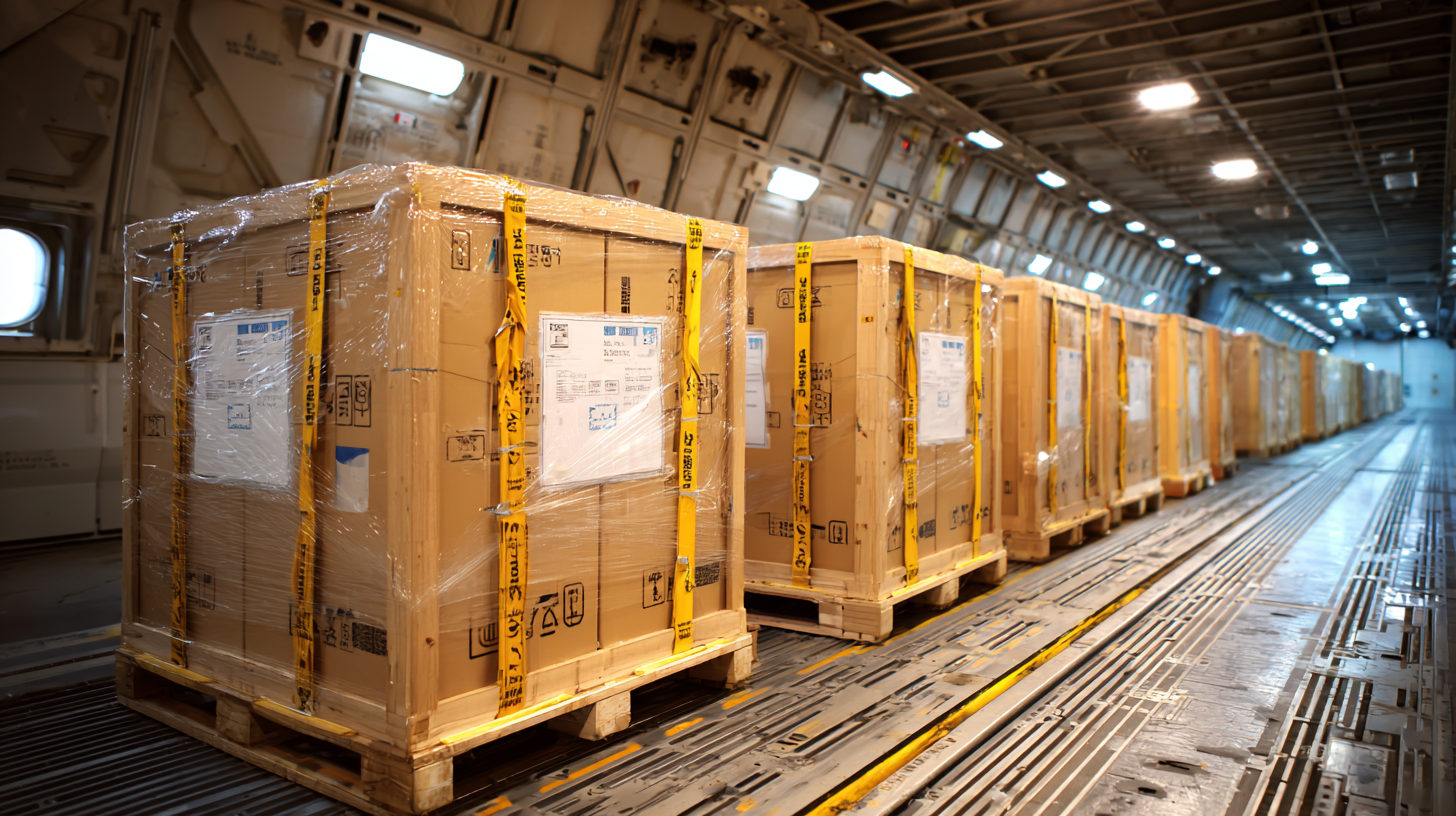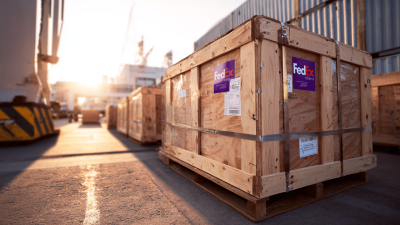How to Ship FedEx Lithium Batteries Safely and Comply with Industry Regulations
 Shipping lithium batteries safely is a critical concern in today's logistics landscape, particularly for companies using FedEx for transportation. According to the International Air Transport Association (IATA), approximately 30% of air cargo globally comprises hazardous materials, with lithium batteries representing a significant portion due to their widespread use in consumer electronics. Improperly packaged or documented lithium batteries can lead to severe safety risks, including fires or hazardous incidents during transit.
Shipping lithium batteries safely is a critical concern in today's logistics landscape, particularly for companies using FedEx for transportation. According to the International Air Transport Association (IATA), approximately 30% of air cargo globally comprises hazardous materials, with lithium batteries representing a significant portion due to their widespread use in consumer electronics. Improperly packaged or documented lithium batteries can lead to severe safety risks, including fires or hazardous incidents during transit.
FedEx lithium battery shipping guidelines align with industry regulations set by organizations such as the United Nations and IATA, providing a framework for safe transport. To maintain compliance and ensure the safety of all stakeholders, it is imperative for shippers to understand and adhere to these guidelines, including proper labeling, packaging, and documentation techniques. This article aims to outline the essential steps to ship FedEx lithium batteries safely and effectively, promoting best practices in a rapidly evolving regulatory environment.
Understanding Lithium Battery Regulations for Shipping
When it comes to shipping lithium batteries, understanding the intricate web of regulations surrounding them is essential for compliance and safety. According to the International Air Transport Association (IATA), lithium batteries that are defective or pose safety risks cannot be shipped by air under Special Provision A154. This provision aims to eliminate ambiguity regarding the transportation of potentially hazardous batteries, emphasizing the need for meticulous adherence to packaging standards. Proper packaging is not merely a precaution; it is a regulatory requirement, specifically when shipping damaged or defective batteries. Ignoring these regulations can lead to severe consequences, including fines and increased safety risks during transport.
Additionally, the UN Model Regulations have introduced significant changes to labeling requirements, formalizing the use of the "Battery Mark" for lithium and sodium batteries. This new labeling system is crucial for ensuring that batteries are handled appropriately throughout the shipping process. As e-commerce continues to rise, so do the shipments of lithium-ion batteries, necessitating a robust understanding of both state and federal regulations. Organizations like the International Safe Containerised Cargo Organisation (CINS) have also stepped in to provide guidance on safely shipping lithium-ion cells in containers, ensuring that all stakeholders are well-informed about the latest safety protocols and industry standards.
Understanding Lithium Battery Regulations for Shipping
Packaging Requirements for Safe Lithium Battery Shipment
When preparing to ship lithium batteries via FedEx, adherence to strict packaging requirements is crucial for compliance with industry regulations and ensuring safety. According to the International Air Transport Association (IATA), lithium batteries are classified as dangerous goods due to their potential fire risk. They must be packaged to withstand potential impacts and prevent short circuits. Specific requirements include using non-conductive materials, proper cushioning, and ensuring that terminals are protected. The IATA recommends that each package should not exceed 300 watt-hours (Wh) for lithium-ion batteries or 300 watt-hours per cell for lithium-ion polymer batteries to minimize risks.
Tip: Always label your shipment clearly, indicating that it contains lithium batteries. This not only ensures compliance but also helps handlers identify the appropriate precautions during transport.
In addition, it is critical to utilize UN-approved packaging materials for shipping, which are designed to meet international regulations. These materials offer robust protection during transit, significantly reducing the risk of incidents. According to a report by the United Nations Committee of Experts on the Transport of Dangerous Goods, almost 80% of battery-related incidents stem from inadequate packaging. Hence, proper adherence to these packaging requirements is essential for safe shipping practices and regulatory compliance.
Tip: Regularly review updates from regulatory bodies to stay informed about any changes in shipping requirements or best practices related to lithium batteries.
Labeling and Marking Guidelines for Lithium Battery Packages
When shipping lithium batteries, compliance with labeling and marking guidelines is essential to ensure safety and adherence to industry regulations. As outlined by the International Safe Containerised Cargo Organisation, packages containing lithium-ion cells must feature specific labels that clearly indicate the nature of their contents. This includes the revised "Battery Mark" label as per UN Model Regulations, which highlights the potential hazards associated with lithium batteries during transport. All shippers are required to familiarize themselves with these guidelines to avoid penalties and enhance safety throughout the shipping process.
In addition to these labeling requirements, recent changes from the U.S. Department of Transportation emphasize the importance of proper packaging and marking for air transport. New policies have emerged to streamline compliance, particularly amid the rising eCommerce shipping trends. It is critical for shippers to stay informed about updated regulations and labeling standards, as failure to comply not only endangers lives but also complicates logistics. By adhering to these detailed guidelines, shippers can ensure that they transport lithium batteries safely and effectively, while also meeting necessary regulatory obligations.
Best Practices for Choosing a Shipping Method with FedEx
When it comes to shipping lithium batteries with FedEx, choosing the right shipping method is crucial for compliance and safety. FedEx offers various options tailored to secure the transport of hazardous materials. It's essential to familiarize yourself with FedEx’s specific requirements for lithium batteries, including labeling and packaging standards. Ensure that your shipment is categorized correctly—whether it's lithium-ion or lithium-metal—as this can affect the shipping method you select.
Tips: Always use strong packaging that can withstand potential hazards. Opt for original manufacturer packaging when possible, as it is designed to protect the batteries during transit. Additionally, be mindful of weight limits and regulations pertaining to the quantity of batteries shipped.
Consider using FedEx’s Express options for faster delivery, which can minimize the time batteries spend in transit, thereby reducing risks. For larger shipments, FedEx Freight may be a suitable alternative, but ensure that each package complies with clear labeling and documentation requirements to avoid delays or penalties.
Steps to Ensure Compliance with FedEx and DOT Regulations
Shipping lithium batteries requires strict adherence to regulations laid out by both
FedEx and the Department of Transportation (DOT). According to the
International Air Transport Association (IATA), improper handling of
lithium batteries has been a significant factor in air transport incidents, highlighting the
importance of compliance. When preparing lithium batteries for shipment, ensuring that they are
packaged in accordance with UN 3480 (for standalone batteries) or UN 3481 (for batteries
contained in or packed with equipment) is crucial. Packages must be marked with the appropriate
hazard symbols and accompanied by the required documentation, such as a
Declaration of Dangerous Goods.

To maintain compliance, shippers must also adhere to weight limits, as the DOT mandates that
lithium-ion batteries with a watt-hour rating exceeding 100 must not exceed
300 watt-hours per package when shipped by air. Additionally, FedEx requires that
all lithium battery shipments undergo a thorough inspection before transit, ensuring that each
package is free of damage and the terminals are protected to prevent short-circuiting. By
following these regulations, shippers not only avoid hefty fines but also contribute to safer
transport, mitigating risks associated with battery fires during transit.


 Shipping lithium batteries safely is a critical concern in today's logistics landscape, particularly for companies using FedEx for transportation. According to the International Air Transport Association (IATA), approximately 30% of air cargo globally comprises hazardous materials, with lithium batteries representing a significant portion due to their widespread use in consumer electronics.
Shipping lithium batteries safely is a critical concern in today's logistics landscape, particularly for companies using FedEx for transportation. According to the International Air Transport Association (IATA), approximately 30% of air cargo globally comprises hazardous materials, with lithium batteries representing a significant portion due to their widespread use in consumer electronics. 








